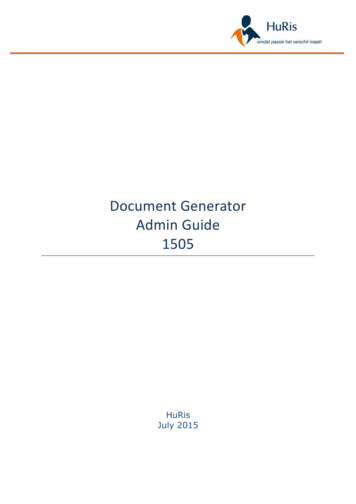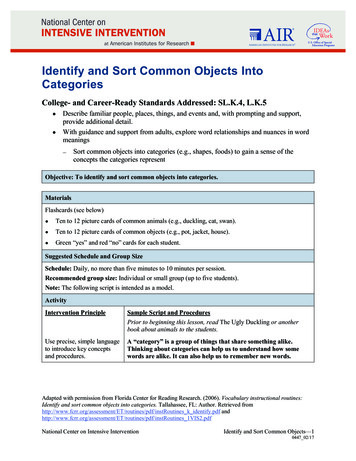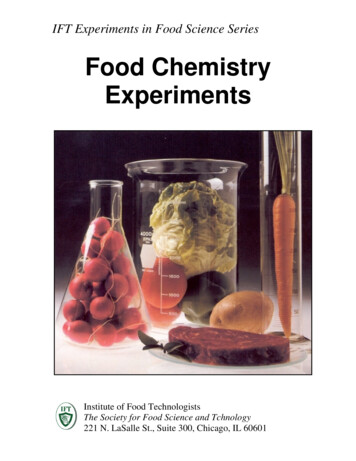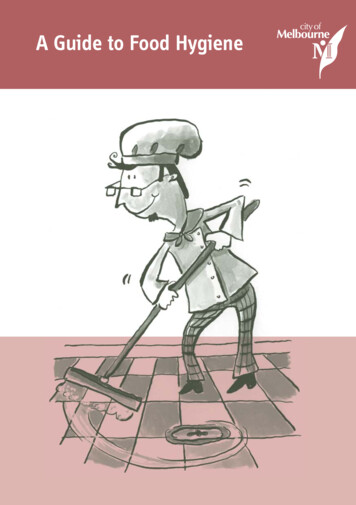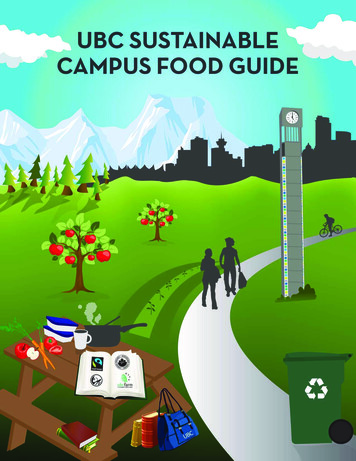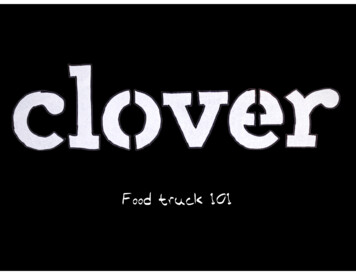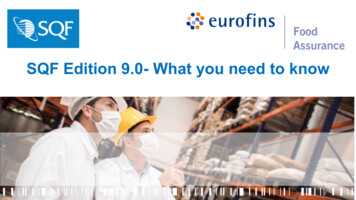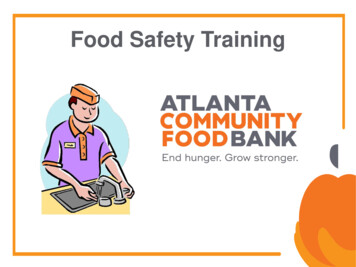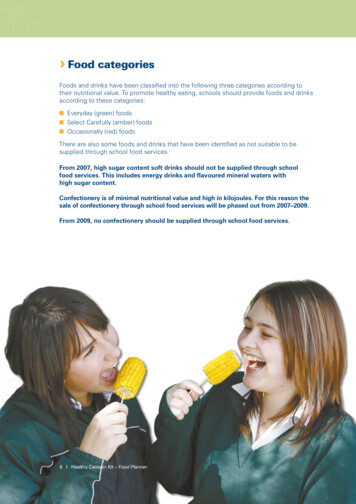
Transcription
› Food categoriesFoods and drinks have been classified into the following three categories according totheir nutritional value. To promote healthy eating, schools should provide foods and drinksaccording to these categories: Everyday (green) foods Select Carefully (amber) foods Occasionally (red) foods.There are also some foods and drinks that have been identified as not suitable to besupplied through school food services.From 2007, high sugar content soft drinks should not be supplied through schoolfood services. This includes energy drinks and flavoured mineral waters withhigh sugar content.Confectionery is of minimal nutritional value and high in kilojoules. For this reason thesale of confectionery through school food services will be phased out from 2007–2009.From 2009, no confectionery should be supplied through school food services. I Healthy Canteen Kit – Food Planner
OccasionallySelect CarefullyEverydayThe three food categoriesFoods and drinks in the Everyday categoryare most suitable for school food services.Schools should:444444encourage and promote these foodsprovide a wide range of these foods every dayinclude as the main choices on the canteen menupromote these foods as tasty, fresh and good value choicespresent these foods in attractive and interesting waysinclude as the main choices at school events andactivities involving food.everydayFoods and drinks in the Select Carefully categorycontain some valuable nutrients, but may alsoinclude unhealthy ingredients.select careSchools should:4 not let these foods and drinks dominate the canteen menu4 serve in smaller sizes4 limit selling times.Foods and drinks in the Occasionally categoryare not recommended for school food services.occasionalThese foods and drinks:4 should not be on the regular canteen menu4 should be supplied on no more than two occasions per term4 should not be regularly available in other areasof the school such as vending machines.Healthy Canteen Kit – Food Planner I
› Everyday category (green foods)Foods and drinks from the Everyday category are consistent with the Dietary Guidelinesfor Children and Adolescents in Australia and are most suitable for school food services.Providing a wide range of these healthy foods is important for variety. Foods and drinksin this category should be promoted as tasty, fresh and good value choices. These foodsshould be included as part of the canteen menu wherever possible.Foods and drinks in the Everyday category are based on the basic food groupsand include: breads and cereals, rice, pasta, noodles vegetables fruits dairy foods – reduced or low-fat milk, yoghurt and cheese lean meat and poultry, fish, eggs, nuts* and legumes(dried beans and lentils) water.These foods and drinks are the best choices because they: are often high in nutrients and fibre are low in saturated fat and/or added sugars and/or salt help to avoid an excess kilojoule intake.Within this category even healthier choices can be made.Wholegrain breads and cereal products are higher in fibre,for example grainy bread, high-fibre breakfastcereals, air-popped popcorn.Refer to the food guide tables onpages 16–24 for more informationon foods and drinks in thiscategory.Water is also an important part ofthe Everyday category.*Food allergies are the most common triggers foranaphylaxis (severe allergic reaction) in children. Eight foodscause 90 per cent of food allergies: peanuts, cow’s milk,egg, wheat, soybean, tree nuts (for example, cashew), fishand shellfish. Schools should be aware of the risk of hiddenallergens. Check your school’s policy regarding students withsevere allergies.odsYDAY foREVErt foChecklise mainoften as th u.tsomedIncluteen men4 choices on the cany dayilable everavaekaM.4 the canteen is openndcourage anelygnorStndese foods ahtetomor4 pdrinks.hoiceshe main ctsaedluitiesIncand activstnevelo4 at scho g food and drink.involvin I Healthy Canteen Kit – Food Planner
› Select Carefully category (amber foods)Not all foods and drinks sit in the Everyday or Occasionally categories. In between are arange of foods and drinks that contain some valuable nutrients but may also have someunhealthy ingredients. These foods are included in the Select Carefully category.Examples of foods and drinks in this category include: full-fat dairy foods – milk, yoghurt and cheese processed meats commercially prepared hot foods margarines, oils, spreads, sauces and gravies snack food bars (for example, breakfast bars, cereal bars, fruit bars) cakes, muffins, sweet biscuits, slices savoury snack foods and biscuits low or reduced-fat ice-creams, milk-based ice confections and dairy desserts ice blocks and ice slushees based on 100 per cent fruit juice drinks – 100 per cent fruit juices, some moderate-kilojoule sports waters artificially sweetened drinks some breakfast cereals (with added sugar and/or saturated fat and low fibre).Foods and drinks on canteen-registered product buyer guides generally fall into the SelectCarefully category. These foods should be selected carefully because they: are moderate in added fat and/or sugar and/or salt contribute to excess kilojoules if consumed in large serve sizes. provide some nutritional value.Refer to the food guide tables on pages 16–24 for more information onfoods and drinks in the Select Carefully category.Note: Some of the food types listed above may fit into eitherthe Select Carefully category or the Occasionally category.Read the labels and assess against the nutrient criteria forOccasionally foods. (Refer to page 13).Healthy Canteen Kit – Food Planner I
t forChecklis LY foodsLCAREFUSELECTfoods andesehttletDo nothe menu.4 drinks dominatee sizes.large servidovA4theseumber ofnehtec.uRedeen menutnaceht4 foods onnods only oofesehtrOffeeks of the weyadinat.4 cerlling timeesitmliroier choiceshltaehtcSeleory.4 within this categfoodss of theseeicohctc/orSelefruits andinatnocitstthave with fruresrosle4 vegetabgetables.and/or veslyote vigorou dmorptonDods annse of fooepxeehttaEveryday4 drinks from thecategory.To help avoid large serve sizes: consider appropriate serve sizes for primaryand secondary students – have ‘mini’options and half-serves for lower primaryaged students limit juice and flavoured milk serves(refer to the food guide tables onpages 16–24) take serve sizes into consideration whenpacking, preparing and serving foodsNote: many food companies are nowstarting to offer child-appropriateserve sizes.Special dietary requirementsSome students require special diets for medical reasons. The school principal, child’steacher or parents should provide advice of any special dietary needs to canteen staff.Medical conditions that have special dietary requirements include: diabetes coeliac disease anaphylaxis.Anaphylactic (severe) food allergyContact with certain foods can be fatal for people with allergies to these foods.The most common triggers of anaphylaxis are: peanuts, cow’s milk, egg, wheat,soy, tree nuts (for example, cashews), fish and shellfish. The Department ofEducation & Training has guidelines for schools to support students with anaphylaxis.For more information, go to: m.Absolute and strict avoidance of nuts and nut products is extremely important foranyone with an anaphylactic nut allergy.Canteen staff need to be well aware of students with such allergies and familiar withthe school’s management strategies for these students.For detailed information on special dietary requirements refer to ‘Go for your life’Healthy Canteen Kit – Canteen Manual, page 9.10 I Healthy Canteen Kit – Food Planner
› Occasionally category (red foods)Foods and drinks in this category are not consistent with the Dietary Guidelines forChildren and Adolescents in Australia and are not suitable for school food services.Foods and drinks in this category are based on the ‘extra foods’ as defined in theAustralian Guide to Healthy Eating and include: sugar-sweetened drinks – sports drinks, cordial, fruit-flavoured drinksdeep-fried foodspastry-based or crumbed hot foodssavoury snack foods – crisps, chips,biscuits and other similar productsice-creams, ice confections and dairydesserts, for example chocolate-coatedand premium ice-creams, icy-polescakes, muffins, sweet biscuits, slices,bars, donuts, danishes, croissantscream, butter, copha and chocolatespreads.These foods and drinks are the least suitableas, generally, they: are very low in nutritional value are high in saturated fat and/or added sugarand/or added saltt forChecklisoodsNALLY fIOSACCOsand drink larsdoofeseThregut be on theonlduoh4 senucanteen my ofavailabilit toLimit thekss and drin ionsthese foodoccas4 no more than twoper term.sand drinksdoofeseThrlyt be regulashould noother areasailable invain4ol such asof the schoachines.vending m provide excess kilojoules.Foods and drinks which fit into the Occasionally (red foods) categoryshould be supplied on no more than two occasions per term.There are many foods and drinks that may fall into either the Occasionally category or theSelect Carefully category. Read the labels and assess against the nutrient criteria for anOccasionally food. The food guide tables on pages 16–24 provide more information onthe types of foods that fall into the Occasionally category.From 2007, high sugar content soft drinks should not be supplied through schoolfood services. This includes energy drinks and flavoured mineral waters with highsugar content.Confectionery is of minimal nutritional value and high in kilojoules. For this reasonthe sale of confectionery through school food services will be phased out from2007–2009.From 2009, no confectionery should be supplied through school food services.Healthy Canteen Kit – Food Planner I 11
How to identify foods and drinks in the Occasionally categoryThe following tables list a set of nutrient criteria* for certain types of foods and drinks thatmay fall under the Occasionally category.These nutrient criteria tables are a useful tool to determine if a particular food fits intoeither the Select Carefully category or Occasionally category.There are nutrient criteria for two types of food groupings: hot food items snack foods and drinks.These food types are the most likely to fit into the Occasionally category. Food types suchas fruit and vegetables do not require assessing against nutrient criteria as these foodsare usually in the Everyday category.The nutrient criteria have been developed specific to each food category’s characteristics.Note that: total fat and sugar have not been included within the nutrient criteria. A total kilojoule(energy) criteria limit has been set, which indirectly limits the amount of fat and sugarthat can be included in a food hot foods are assessed per 100 grams to allow for the wide variation in serve sizeswithin this group snack foods and drinks are assessed per serve as this grouping is generallypre-packaged into individual serves in the snack foods and drinks category large serve sizes and excess energy intake havebeen addressed by limiting the kilojoule content per serve.*Based on the Fresh Tastes @ School, NSW Healthy School Canteen Strategy Occasional Food Criteria.12 I Healthy Canteen Kit – Food Planner
Nutrient criteria for Occasionally foodsIf the food item you are considering has more than the number specified in the energy,saturated fat or sodium column, or less than the number in the fibre column, it is anOccasionally food.Hot food items (assessed per 100 g)Energy (kJ)per 100 gSaturated fat (g)per 100 gSodium (mg)per 100 gSavoury pastries,pasta, oven-bakedpotato products 1000 kJ 5 g 400 mgCrumbed and coatedfoods, frankfurts,sausages 1000 kJ 5 g 700 mgFoodBased on the Fresh Tastes @ School, NSW Healthy School Canteen Strategy Occasional Food Criteria.Note: All types of deep-fried foods fit into the Occasionally category and are not recommended for supply in schoolsas they are too high in kilojoules and fat.Snack foods and drinks (assessed per serve)Saturatedfat (G)per SERVEFood ordrinkEnergy (kJ)per SERVESweeteneddrinks andices* 300 kJSnack foodbars and sweetbiscuits 600 kJ 3 gSavoury snackfoods andbiscuits 600 kJ 3 gIce-creams,milk-based iceconfections,dairy desserts 600 kJ 3 gCakes, muffins,sweet pastries 900 kJ 3 gSodium (mg)per SERVEfibre (g)per serve 100 mg 1.0 g 200 mg 1.5 gBased on the Fresh Tastes @ School, NSW Healthy School Canteen Strategy Occasional Food Criteria.*The sweetened drinks and ices category applies to cordials, fruit-flavoured drinks, sports drinks, sports waters,ice blocks and ice confections.Healthy Canteen Kit – Food Planner I 13
Example 1Following is an example of an assessment of a hot food using the nutrient criteria forOccasionally foods. This food product is a hot food, so refer to the nutrient criteria for hot foods(see page 13, Crumbed and coated foods, frankfurts and sausages). Refer to the per 100 G column on the food label for assessing hot foods. Compare the nutrients on the food product label with the corresponding nutrientvalues in the nutrient criteria table on the previous page.Crumbed chickenfillet burgerPer 120 gservePer 100 gEnergy1176 kJ980 kJProtein17.4 g14.5 gFat – total– saturated15.8 g4.1 g13.2 g3.4 gCarbohydrates – total– sugars18.3 g0.2 g15.3 g0.2 gSodium734 mg612 mgEnergy: 980 kJ per 100 gThe result is as follows:is less than ( ) 1000 kJFat, saturated:3.4 g sat. fat per 100 gis less than ( ) 5 gSodium: 612 mgsodium per 100 g isless than ( ) 700 mg Energy: 980 kJ per 100 g is less than ( ) 1000 kJ. Fat, saturated: 3.4 g sat. fat per 100 g is less than ( ) 5 g. Sodium: 612 mg sodium per 100 g is less than ( ) 700 mg.These values are all less than the nutrient criteria; therefore this food is not anOccasionally food and can be included in the Select Carefully category.14 Healthy Canteen14 I HealthyKit – FoodCanteenPlannerKit – Food Planner
Example 2Following is an example of an assessment of a snack food using the nutrient criteria forOccasionally foods. This food product is a snack food so refer to the nutrient criteria (page 13) for snackfoods (Savoury snack foods and biscuits). Refer to the per serve column on the food label for assessing snack foods and drinks. Check if the specified serve size on the label is your canteen’s actual serve size.Assess the serve size as served in your canteen, for example the serve listed on thefood label may be sixteen biscuits, whereas your canteen may bag up twenty biscuits. Compare the nutrients on the food product label with the corresponding nutrientvalues in the nutrient criteria table on page 13.baked savourybiscuitPer Serve(16 Biscuits,35 g)Per 100 gEnergy770 kJ2195 kJProtein5.2 g14.8 gFat – total– saturated8.8 g3.9 g25.1 g11.1 gCarbohydrates – total– sugars20.4 g1.1 g58.1 g3.2 gFibre1.4 g4.0 gSodium238 mg678 mgThe result is as follows:Energy: 770 kJ per serveis greater than ( ) 600 kJFat, saturated: 3.9 gsat. fat per serve isgreater than ( ) 3 gSodium: 238 mgsodium per serve is greaterthan ( ) 200 mg. Energy: 770 kJ per serve is greater than ( ) 600 kJ Fat, saturated: 3.9 g sat. fat per serve is greater than ( ) 3 g Sodium: 238 mg sodium per serve is greater than ( ) 200 mg.This snack food product at this serving size is not within the nutrient criteria and thereforefalls in the Occasionally category. Do not include these biscuits on the menu and look fora healthier choice.Healthy Canteen Kit – Food Planner I 15
low or reduced-fat ice-creams, milk-based ice confections and dairy desserts ice blocks and ice slushees based on 100 per cent fruit juice drinks - 100 per cent fruit juices, some moderate-kilojoule sports waters artificially sweetened drinks some breakfast cereals (with added sugar and/or saturated fat and low fibre).
